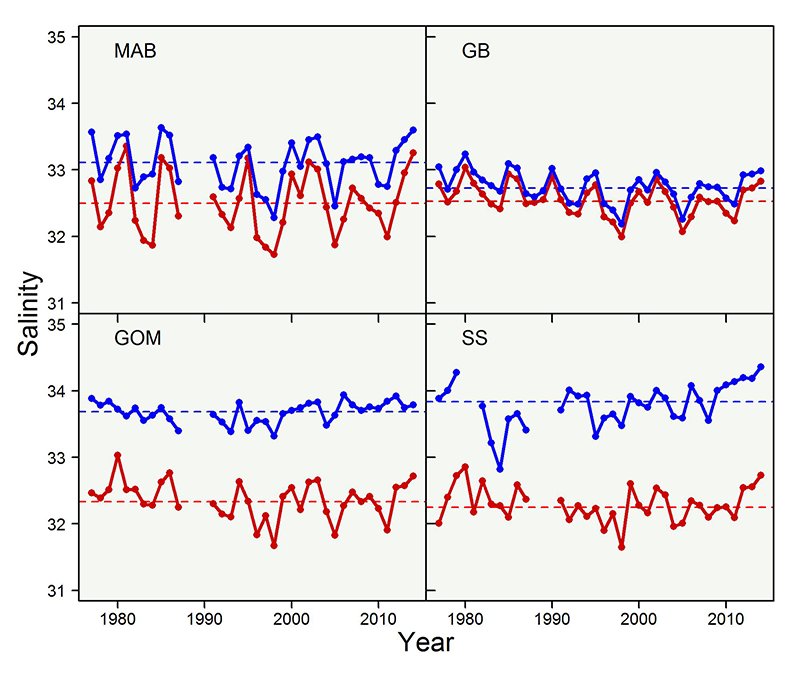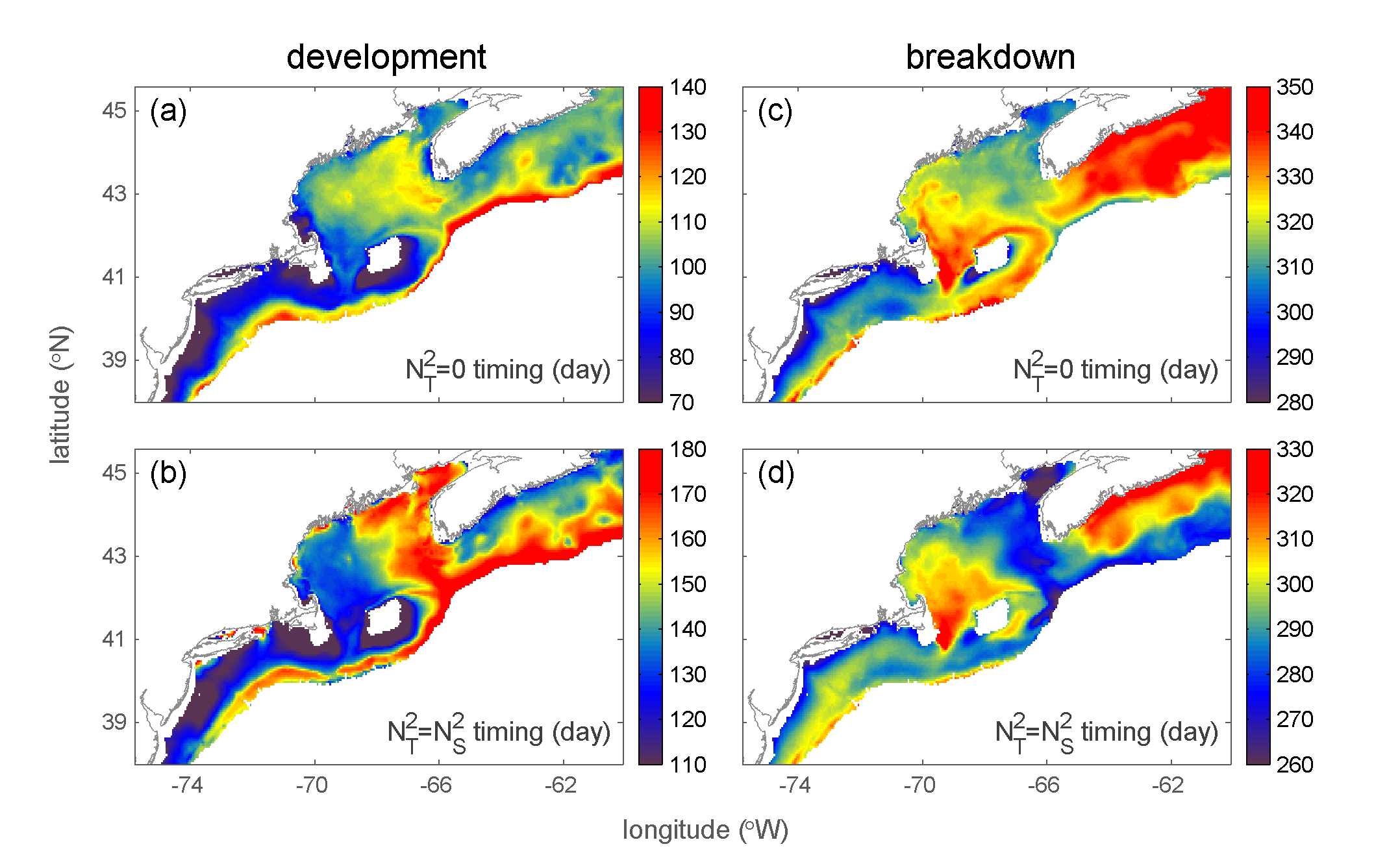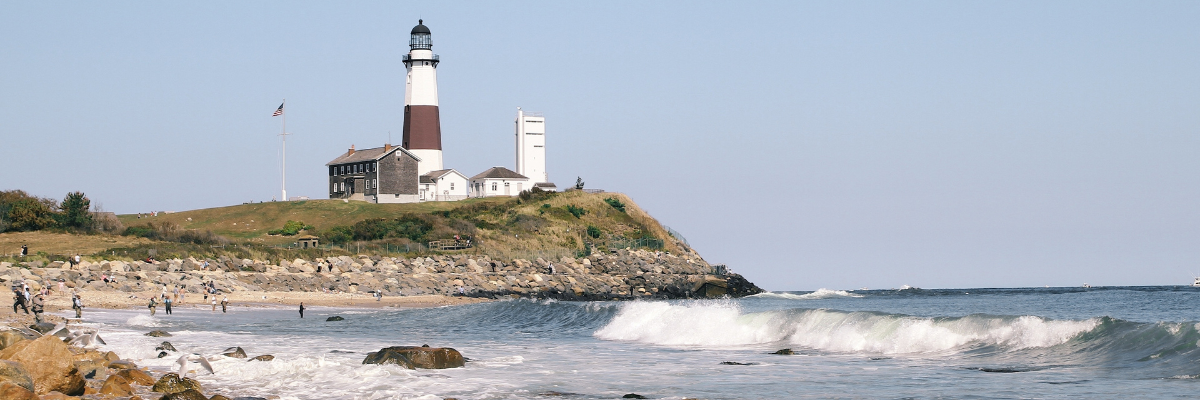Salinity
There is strong geographic variation in salinities across the northwest Atlantic. Input from fresh, cold Scotian shelf water and warmer, saltier slope water flowing through the Northeast Channel at depth result in three distinct water masses in Gulf of Maine. The saltiest and deepest is Maine Bottom Water, while the overlying Maine Intermediate Waters and Maine Surface Waters are fresher and warmer (Townsend et al. 2004). Salinities on Georges Bank are relatively stable and slightly more saline than Maine Surface Water, which could indicate interaction with deeper, saltier Maine Bottom Water (NEFSC Oceanography). In the southern and central Mid-Atlantic Bight, nearshore salinities tend to be lower due to freshwater input from rivers and estuaries, becoming saltier towards the shelf-break. In the northern Mid-Atlantic, freshwater input lessens, but fresher water lies inshore of more saline water as in the south (Castelao et al. 2010). This contrast is accentuated at the shelf break, where a sharp temperature and salinity front separates cool and fresh coastal waters from warm and salty slope waters offshore.

Freshwater Discharge
The fresh continental runoff entering the shelf from rivers and tributaries in the Middle Atlantic Bight is several times larger than the Gulf of Maine and the majority of this input is centered in the southern Middle Atlantic Bight, provided by the Hudson, Susquehanna, and Delaware Rivers. Peak freshening from local freshwater runoff to the Northeast Shelf occurs within a 3-month period between March and May. This seasonal freshening is responsible for increasing the stratification in near shore waters and enhancing cross-shelf salinity gradients and flow along the inner shelf, particularly inshore of the 60 m isobath (Lentz 2008, Castelao et al. 2010). However, because most of the cold/fresh shelf water feeding the NES arrives from the north, the entire shelf experiences a freshening several months after the period of local run-off, with inter-annual variations that often swamp local annual variability.
Climate-change induced freshening of surface waters flowing into eastern Gulf of Maine is increasing stratification and affects changing primary productivity patterns as a result. The inputs of rivers and other continental sources provide nutrients to the NES which stimulate phytoplankton and primary productivity. While the overall contribution of rivers is less than offshore sources, continental sources provide a locally important contribution in river plumes and are supplied directly into the biologically productive surface zone. While nitrate is the primary limiting nutrient within the NES, dissolved silicate is required by diatoms to sustain intense blooms. In contrast to nitrate, silicate concentrations in river water are significantly higher than those offshore and continental sources provide approximately equal quantities of silicate as offshore and deepwater sources (Rebuck 2011).
Stratification
The magnitude and timing of stratification in the northwest Atlantic are key determinants of phytoplankton bloom phenology and strength, although stratification exhibits high seasonal and spatial variability throughout the region (Li et al. 2015). As stratified layers in the water column form and break down, nutrients are mixed vertically and phytoplankton are moved into or out of the euphotic zone. Salinity gradients drive stratification during the winter and early-spring when thermal gradients are minimized and stratification is at its weakest. In the spring and summer months, thermally driven stratification increases in association with surface heating.
Following a peak period, surface cooling and wind-induced mixing cause the breakdown of the seasonal thermocline in fall (Li et al. 2015, Castelao et al. 2010). Georges Bank is dominated by tidal mixing currents across most of its area but especially within the 60 m isobath, where the water column remains vertically mixed throughout the year (Townsend et al. 2004). In the Gulf of Maine, variations in the seasonal cycle of temperature and salinity result in the western Gulf being more highly stratified in summer and more vertically uniform in winter than the eastern GOM (Mountain & Manning 1994).

Winds
Winds are an important pressure on the Northeast Shelf that can alter regional circulation patterns, drive vertical currents near the boundary, and weaken vertical property gradients (stratification) by enhancing vertical mixing. In the Mid-Atlantic Bight,wind-forcing plays an important role in coastal upwelling, where northerly winds can drive upwelling events during summer months. Episodic surface winds also tend to dictate the direction and strength of short-term along-shore flow in the region (Glenn et al. 2004). Winds are important in facilitating the development of the halocline in southern New England, where freshwater outflow is driven offshore by eastward blowing winds (Lentz 2003). In the fall, westward blowing winds play an important role in breaking down thermally stratified waters in southern New England, resulting in vertical mixing of the water column (Lentz 2003). There is evidence that wind fluctuations associated with the passage of atmospheric low-pressure systems, may play an important role in the transport and retention of particles and dissolved nutrients across the tidal mixing front on Georges Bank (Chen et al. 2003).
